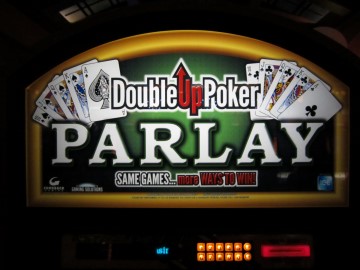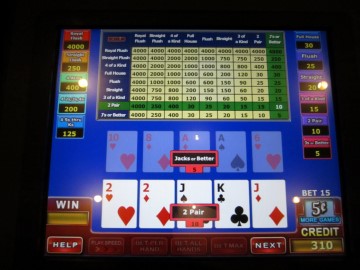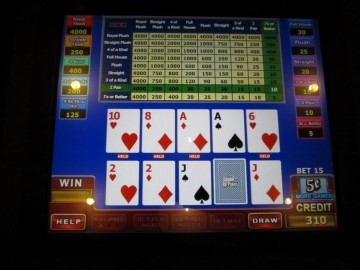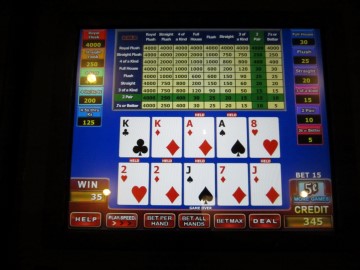
Click any image for larger version.
It plays like regular video poker except:
1. The player bet 15 credits at a time and gets two hands dealt from separate decks.
2. The player is paid based on the the poker value of each final hand as well as a third win based on the value of both hands.
The concept if both hands score high then the player wins a lot on the "parlay" portion. Here is an example.

In the hand above you can see both initial hands. The bottom one is illuminated because I play out that one first.

Here I hold the two pair on the bottom hand and then the top hand is illuminated to direct my attention to playing that one.

I held the pair of aces on the top hand. Then the draw cards are dealt to both hands. I end up with a two pair on both.
From the base pay table I'm paid 10 credits for each two pair. On the parlay pay table I'm paid 15 based on the score of both hands. So, my total win is 10+10+15=35.
My first question is whether this is a new game or has been around for years and I am just seeing it for the first time. As a west side resident, I don't get out to the GVR very often.
It would be easy to analyze with an assumption that the player didn't make any strategy deviations for the parlay portion. However, if one considers this then the analysis really becomes a bear. I get 15,893,347,154,073,300,000,000,000 possible combinations. I tip my hat to whoever did a combinatorial analysis of this one, if anybody.
You made a mistake in your adding above though. You say "From the base pay table I'm paid 10 credits for each two pair. On the parlay pay table I'm paid 15 based on the score of both hands. So, my total win is 10+10+15=25." 10+10+15 equals 35, which is what is show as the total win in the picture.
ZCore13
Quote: Zcore13You made a mistake in your adding above though. You say "From the base pay table I'm paid 10 credits for each two pair. On the parlay pay table I'm paid 15 based on the score of both hands. So, my total win is 10+10+15=25." 10+10+15 equals 35, which is what is show as the total win in the picture.
Well, that was embarrassing. Thanks for the correction.
Quote: WizardMy first question is whether this is a new game or has been around for years and I am just seeing it for the first time. As a west side resident, I don't get out to the GVR very often.
I feel like you should have asked this question for "Extra Action Poker".
http://media.igt.com/marketing/PromotionalLiterature/GamePromoLit_1D58E-201BE.pdf (media sheet copyright in 2011)
You can play the game for "Extra Action Poker" for free at videopoker.com
Media Sheet for "Double Up Parlay" (copyright 2013), and I never saw it even until you posted this.
It also follows the new IGT standard of not permitting 99%+ video poker...grrrrrrrrrrrrrrrrrrrrrrr
http://comebackgaming.com/assets/parlay-video-poker-sales-sheet.pdf
But you can play a free game here:
http://www.advancedgamingsolutions.com/games/Comeback/bundles/parlaypkr/loader.html
Ouch!
ZCore13
Quote: Zcore13I think I might have just changed my mind on this game. Just got my butt handed to me for $250 in about 15 minutes playing the basic Jacks or Better version.
Ouch!
ZCore13
I was sitting there watching you. Lol...no, but looking at the timing, we were trying it at the same time. I played even w/max bets in the same time. The best parley hand I had was FH+somethiing smaller (3oak?) for 200, and I had another for 120. Wasn't too bad, but I did get slightly bored with it. And it seemed odd to me that it didn't pay better than a 4000 bonus for royalxroyal. You'd think that would be so improbable they could pay some crazy amount on it like 20000.
Quote: beachbumbabsAnd it seemed odd to me that it didn't pay better than a 4000 bonus for royalxroyal. You'd think that would be so improbable they could pay some crazy amount on it like 20000.
There is a law in Nevada that the highest possible prize must have a probability of at least p. I keep forgetting what p is, but something like 1 in 20 million. I'm sure MathExtremist knows. The probability of a double royal is about 1 in 1.6 billion.
Quote: WizardThere is a law in Nevada that the highest possible prize must have a probability of at least p. I keep forgetting what p is, but something like 1 in 20 million. I'm sure MathExtremist knows. The probability of a double royal is about 1 in 1.6 billion.
Actually in Nevada you could offer a higher royal/royal payout but you'd have to explicitly write the probability on the glass. Any sane manufacturer would not do this. The threshold for this requirement is 1 in 100 million in Nevada.
Most states outright ban top payouts over the cutoff. This is sorta offhand for some states, particularly CT; I think Crystal Math told me that one.
MS and NJ: 1 in 100 million
Most states and GLI-11 standard: 1 in 50 million
CT: 1 in 17 million?
CO (non network games): 1 in 17 million
CO (network games): 1 in 50 million
So 1 in 17M is the "catch-all" probability. With that in mind, that affects my favorite video poker variant. For Double Super Times Pay, they automatically award 20X the Royal with a dealt Royal and any deal multiplier (~1 in 9.74M). Maybe I'll be lucky enough for this to happen once in my life. ;) If this rule didn't exist, the probability of a 20X Royal is closer to: 1 in 22.7 billion...lol
For regular Super Times Pay, the highest available Double Bonus game I am aware of is 10/6 and not 9/7. With 9/7 the probability of a 10X Royal would be > 1 in 18 million, which would be illegal in a few states at least.
You're looking at it wrong.Quote: WizardThere is a law in Nevada that the highest possible prize must have a probability of at least p. I keep forgetting what p is, but something like 1 in 20 million. I'm sure MathExtremist knows. The probability of a double royal is about 1 in 1.6 billion.
Yeah, a double royal is damn rare, but a royal with jacks OR BETTER is far more common. And, since a royal with anything pays the same regardless of what the anything is, it's well within the limit.
Quote: DJTeddyBearYou're looking at it wrong.
Yeah, a double royal is damn rare, but a royal with jacks OR BETTER is far more common. And, since a royal with anything pays the same regardless of what the anything is, it's well within the limit.
I think when we first did this game we were paying 20,000 coins for a royal with a straight or better.
Quote: DRichI think when we first did this game we were paying 20,000 coins for a royal with a straight or better.
And I think something like that would have better than the current setup, imo. But I guess you get a nice 4000 credit boost roughly 45% of the time.
| Hand | Return |
|---|---|
| Red | 0.983927 |
| Blue | 0.983927 |
| Parlay | 0.974444 |
| Total | 0.980766 |
So the extra feature lowers the overall return. Now I'm sure with optimal strategy that considers the parlay feature that would go up, but how many people on earth are going to learn such a strategy unless the game gets over 100%, which I'm sure it doesn't?
The next table shows the return table for the parlay portion. The return column is the product of the win, probability, and 0.2. The reason for multiplying by 0.2 is the wins are based on a 5-coin bet.
| Parlay Win | Probability | Return |
|---|---|---|
| 4000 | 0.000023 | 0.018014 |
| 2000 | 0.000009 | 0.003446 |
| 1000 | 0.000241 | 0.048275 |
| 800 | 0.000405 | 0.064776 |
| 750 | 0.000019 | 0.002810 |
| 500 | 0.000375 | 0.037490 |
| 400 | 0.001625 | 0.129981 |
| 250 | 0.000075 | 0.003759 |
| 200 | 0.000259 | 0.010345 |
| 120 | 0.002088 | 0.050105 |
| 90 | 0.001640 | 0.029519 |
| 60 | 0.001672 | 0.020070 |
| 50 | 0.005543 | 0.055425 |
| 40 | 0.007917 | 0.063337 |
| 30 | 0.007575 | 0.045448 |
| 20 | 0.007725 | 0.030899 |
| 15 | 0.067912 | 0.203736 |
| 10 | 0.055481 | 0.110963 |
| 5 | 0.046046 | 0.046046 |
| 0 | 0.793372 | 0.000000 |
| Total | 1.000000 | 0.974444 |
Quote: WizardI did some more math on Double Up. For the $1 8-5 Jacks game, assuming the player follows optimal 8-5 strategy, here is the return of each component, as well as the average.
Hand Return Red 0.983927 Blue 0.983927 Parlay 0.974444 Total 0.980766
You mean 8/6 JoB, right? 8/5 JoB is 97.3%.
Quote: WizardI did some more math on Double Up. For the $1 8-5 Jacks game, assuming the player follows optimal 8-5 strategy, here is the return of each component, as well as the average.
Hand Return Red 0.983927 Blue 0.983927 Parlay 0.974444 Total 0.980766
So the extra feature lowers the overall return. Now I'm sure with optimal strategy that considers the parlay feature that would go up, but how many people on earth are going to learn such a strategy unless the game gets over 100%, which I'm sure it doesn't?
There might be an interesting question for your next FOIA request. I was under the impression that each additional coin wagered in a machine game could not have a lower RTP than the previous coin, and this wouldn't qualify. Am I wrong about that in Nevada?
Quote: tringlomaneYou mean 8/6 JoB, right? 8/5 JoB is 97.3%.
Yes, I meant 8/6.
Quote: MathExtremistThere might be an interesting question for your next FOIA request. I was under the impression that each additional coin wagered in a machine game could not have a lower RTP than the previous coin, and this wouldn't qualify. Am I wrong about that in Nevada?
The return only goes down if the player sticks with 8-6 strategy. I assume that a more aggressive strategy, especially on the second hand if the first hand scores high, would increase the return.
Quote: MathExtremist
There might be an interesting question for your next FOIA request. I was under the impression that each additional coin wagered in a machine game could not have a lower RTP than the previous coin, and this wouldn't qualify. Am I wrong about that in Nevada?
Rescanning the NV regulations, I think you're wrong. But I could have missed one legal sentence; I perused pretty fast. You're definitely right about some other states though. Regardless, what Wiz currently shows is likely NOT from optimal strategy. It's entirely possible that correlating the two hands dealt to you optimally will make the combined game pay more than 98.39%. What irks me though is, playing standard strategy does not increase RTP, ala Ultimate X. :( And unlike Ultimate X, I'm not sure if variance/game interest will be enough to cover up this undesirable side effect.

For any given win on the first hand there are specified total wins for any given hand on the second hand by summing the win from the second hand itself and the parlay win. For example, if the first hand is a flush, the following would be the pay table for the second hand, considering both the hand itself and the parlay.
Royal flush 1600
Straight Flush 250
Four of a Kind 225
Full House 108
Flush 106
Straight 28
Three of a kind 21
Two pair 8
Pair 7
Nonpaying hand 0
This kind of adjusted pay table would obviously motivate a conservative strategy to win anything.
Putting these wins through my game return calculator results in an expected return of 1.57548.
Then go backwards and consider these expected wins for the second two wins in playing the first hand.
| Hand | First Hand Pays | Second and Parlay Pay | Total | Probability | Return |
|---|---|---|---|---|---|
| Royal flush | 800 | 383.537701 | 1,183.54 | 0.000020 | 0.008003 |
| Straight Flush | 50 | 39.040890 | 89.04 | 0.000107 | 0.003171 |
| Four of a Kind | 25 | 48.048006 | 73.05 | 0.002357 | 0.057403 |
| Full House | 8 | 10.231967 | 18.23 | 0.011475 | 0.069734 |
| Flush | 6 | 7.877408 | 13.88 | 0.012621 | 0.058382 |
| Straight | 4 | 4.704761 | 8.70 | 0.011038 | 0.032029 |
| Three of a kind | 3 | 3.789850 | 6.79 | 0.074101 | 0.167711 |
| Two pair | 2 | 2.444352 | 4.44 | 0.128571 | 0.190471 |
| Pair | 1 | 2.097817 | 3.10 | 0.211511 | 0.218407 |
| Nonpaying hand | 0 | 0.983927 | 0.98 | 0.548199 | 0.179796 |
| Total | 0 | - | - | 1.000000 | 0.985107 |
The return in this table is defined as sum(wins)*probability/3. The reason for dividing by 3 is the player must bet 15 credits, and all these wins are based on 5 coins per win.
So, the total return of 8-6 jacks is 98.51%.
Recall the base game was 98.39%, so optimal strategy (which I'm sure nobody will ever use) will increase the return by 0.12%.
ME: I don't think NV has that rule, but I'm almost certain that IGT would never put out a video poker that decreased the return for an extra wager. I remember a rule like that for Louisiana Native American, I think, but they would accept the game with a note from GLI. The only time I ever remember running into this was with a game that had expanding wilds. Because of the reel layout, there were certain lines that paid a little less.
Quote: CrystalMathSo, you get to resolve the first hand before playing the second? That definitely makes the math easier. At first, I assumed that you had to make all of your holds at the same time.
From his description,I think you hold both hands first.
Quote: WizardI held the pair of aces on the top hand. Then the draw cards are dealt to both hands. I end up with a two pair on both.
Back to your thoughtful spot, Wizard. :+)
Quote: mipletBack to your thoughtful spot, Wizard. :+)
Oh bother! You're right, the first hand isn't resolved until the player makes the decision on the second hand. I forgot that. My initial thought that analysis would be a bear was right.
I do think this game would be better if the first hand were resolved before the decision made on the second.
Back to the thoughtful spot.
Quote: Wizard
I do think this game would be better if the first hand were resolved before the decision made on the second.
When we first did this game the first hand was played out before you even received cards for the second hand. I am surprised to hear they changed it.
Quote: CrystalMathME: I don't think NV has that rule, but I'm almost certain that IGT would never put out a video poker that decreased the return for an extra wager. I remember a rule like that for Louisiana Native American, I think, but they would accept the game with a note from GLI. The only time I ever remember running into this was with a game that had expanding wilds. Because of the reel layout, there were certain lines that paid a little less.
I know IGT won't do it but I always assumed it was for regulatory reasons. But you're right, I can't find any regs that say so. I think IGT applies the rule to all other games too, not just VP. Interesting.
And the piece about expanding wilds is interesting. I would have expected that overwriting a symbol with a wild would always increase the RTP of the line.
Quote: MathExtremist
And the piece about expanding wilds is interesting. I would have expected that overwriting a symbol with a wild would always increase the RTP of the line.
Although it would always increase the RTP, the effective symbol distribution can be different for each position. Consider the following reel layout:
A A A B C W D E F F F
Lines containing the top position on the screen will effectively have the following layout:
A A A W W W D E F F F
Lines containing the center position will have this layout:
A A A B W W W E F F F
Lines containing the bottom position will have this layout:
A A A B C W W W F F F
There are two ways to avoid this that I know of:
1. Always structure the reel so that the symbols above and below the wild are the same, like A A A B C W B C F F F. Regardless of the position on the screen, you will be replacing a B and a C with a Wild.
2. Pay all wins before and after the wild expansion.


